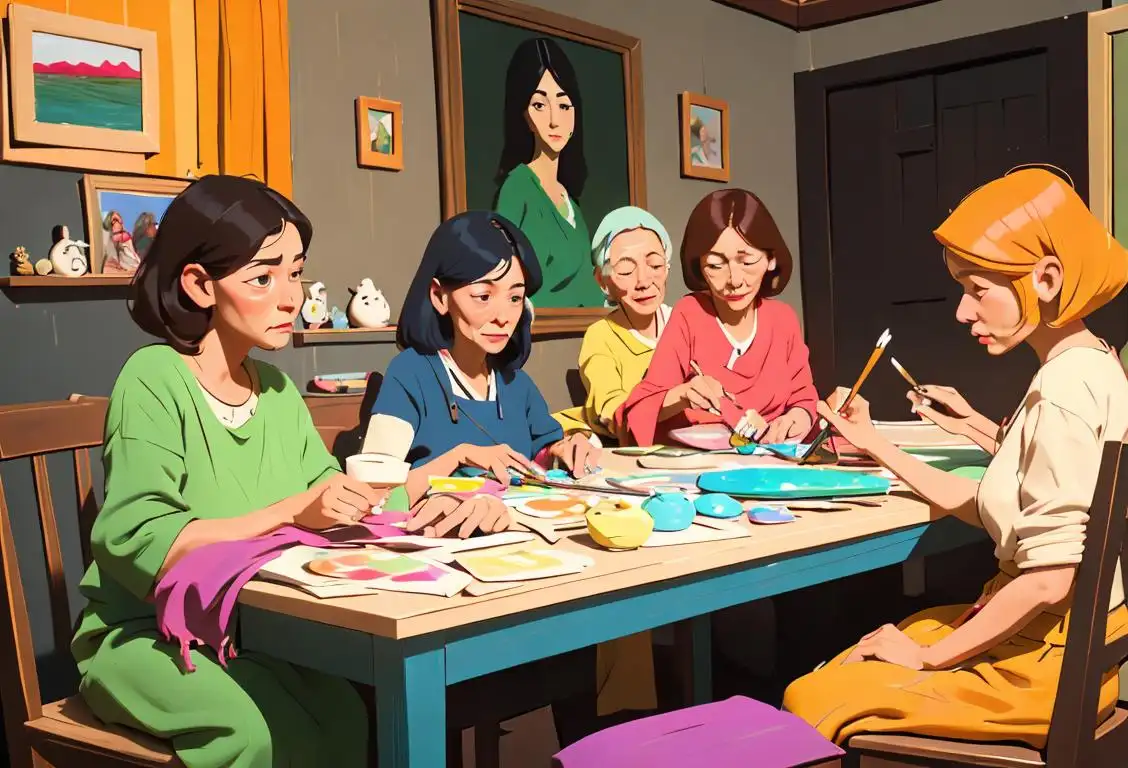National Handmade Day

Happy National Handmade Day! Celebrated on different dates around the world, this crafty holiday brings out the creativity in all of us. Whether you're a DIY enthusiast or just someone who appreciates the beauty of handmade goods, this day is for you. So grab your glue guns, knitting needles, and paintbrushes, because it's time to get crafty!
When is Handmade Day?
It's national handmade day on the 7th April.
The Internet History of National Handmade Day
Back in the early days of the internet, before we could order practically anything with just a few clicks, handmade crafts were a way of life. People would spend countless hours knitting sweaters, making pottery, and sewing clothes for their loved ones. But as technology advanced and online shopping became more popular, the art of handmade goods started to fade into the background.
Recognizing the importance of preserving this tradition, passionate artisans and crafters came together to create National Handmade Day. They wanted to remind people of the love, dedication, and skill that goes into every handmade creation. And so, on this special day, individuals from all walks of life are encouraged to showcase their handmade creations, support local artisans, and embrace the beauty of handmade goods.
A Day for Creativity and Connection
National Handmade Day is not just about buying or making things; it's about fostering creativity and building connections. It's a day to appreciate the time and effort artisans put into their work, and to learn new skills ourselves.
Whether you want to try your hand at pottery, learn to knit, or explore other crafty endeavors, National Handmade Day is the perfect opportunity to do so. You can join workshops, browse local craft fairs, or simply spend an afternoon making something with your own two hands.
Did You Know?
Did you know that the world's largest knitting needles were over 13 feet long? That's right! Created by a British woman named Elizabeth Bond, these gigantic knitting needles were certified as the world's longest by the Guinness World Records. Imagine the size of the scarf you could make with those!
History behind the term 'Handmade'
1000 AD
Origins of Handmade
The term 'handmade' traces its origins back to the year 1000 AD. During this time, most items were crafted by hand, as there were no machines or assembly lines. Skilled artisans painstakingly created a wide range of goods using their expertise and dexterity. Handmade products were seen as valuable and were highly sought after due to the level of artistry and craftsmanship involved.
2000 BCE
Early Beginnings
Handmade items have been produced by skilled craftspeople for thousands of years. The concept of handmade can be traced back to 2000 BCE, when ancient civilizations like the Egyptians and Mesopotamians created intricate crafts and textiles using their hands. These early artisans developed techniques that would lay the foundation for the craftsmanship we admire today.
2000 BC
Ancient Origins
The term 'handmade' originated in ancient times when humans first began to create objects using their hands and simple tools. The earliest evidence of handmade objects can be traced back to the advent of civilization around 2000 BC. These objects were made from natural materials like stone, wood, and clay, and were often used for practical purposes such as food storage, transportation, and shelter. Handmade objects during this time were highly valued for their craftsmanship and served as a means of artistic expression for early civilizations.
12th Century
Craft Guilds and Apprenticeship
In the 12th century, the concept of 'handmade' evolved further with the establishment of craft guilds and the system of apprenticeship. Craft guilds were organizations that regulated the production and sale of handmade goods. They ensured that skilled artisans maintained high quality standards and upheld the traditions of their craft. Apprenticeship was a common practice where young individuals learned a craft under the guidance of a master artisan. This allowed knowledge and expertise to be passed down through generations, leading to the preservation and refinement of various handmade techniques.
15th Century
The Renaissance of Handmade
The Renaissance period, spanning the 14th to the 17th centuries, saw a flourishing of arts and culture. During this time, handmade objects became highly valued and sought after. Skilled artisans and craftsmen created masterpieces in various disciplines, including woodworking, metalworking, and pottery. The term 'handmade' gained recognition as a mark of quality and craftsmanship.
1760s
Rise of the Industrial Revolution
The 1760s marked a significant turning point in the history of 'handmade' with the advent of the Industrial Revolution. This period brought about massive changes in manufacturing processes, as machines began to replace handmade production. With the introduction of mechanization, items could be produced more quickly and in larger quantities. This led to the decline of purely handmade goods, as the efficiency of machines made them more accessible and affordable.
19th Century
Revival of Handmade Crafts
In the 19th century, a revival of interest in handmade crafts emerged as a response to the industrialization of production. Individuals and organizations recognized the loss of artisanal skills and the desire for unique, handcrafted items. This movement helped to preserve traditional crafts and fostered a renewed appreciation for handmade goods. Artisans and craftsmen began to form guilds and societies to pass down their skills and knowledge to future generations.
18th Century
The Industrial Revolution
The 18th century witnessed the advent of the Industrial Revolution, which brought significant changes to the production of goods. As machinery and factories took over, mass production became the norm, leading to a decline in handmade goods. However, the appeal of unique, handcrafted items remained, and a renewed appreciation for the artistry and personalized touch of handmade goods emerged.
18th Century
Industrial Revolution Impact
The industrial revolution in the 18th century brought about significant changes to the concept of 'handmade'. With the invention of new machinery and the rise of mass production, handmade objects faced competition from machine-made goods. This era marked the beginning of a shift towards factory production and a decline in the popularity of purely handmade products. However, certain niche markets and artisan communities continued to value and preserve the art of handmade craftsmanship, ensuring its survival despite the advent of industrialization.
20th Century
Modern Handmade Movement
In the 20th century, there was a resurgence of interest in handmade items as a response to mass-produced consumer goods. The Arts and Crafts movement, which originated in Britain in the late 19th century, championed the value of craftsmanship and the handmade aesthetic. This movement influenced artisans and designers worldwide, leading to the establishment of craft cooperatives, revival of traditional techniques, and recognition of handmade as a symbol of artistic expression.
20th Century
Arts and Crafts Movement
The 20th century witnessed a resurgence of interest in handmade items with the rise of the Arts and Crafts movement. This movement emerged as a reaction to the mass-produced and impersonal nature of industrial goods. Advocating for the importance of individual craftsmanship and the use of traditional handmade techniques, the Arts and Crafts movement revitalized the appreciation for handmade objects. Its influence can still be seen today in the popularity of handmade crafts, artisanal products, and the growing market for unique, one-of-a-kind handmade items.
Late 20th Century
Handmade in the Modern Age
With the rise of globalization and mass production, the concept of 'handmade' faced new challenges in the late 20th century. However, it also experienced a resurgence as people sought out individuality and authenticity in a world saturated with mass-produced items. The internet played a crucial role in connecting artisans with a global audience, allowing them to showcase and sell their handmade products directly to consumers. This led to the growth of online marketplaces and platforms dedicated to supporting handmade crafts.
Present Day
Handmade as a Lifestyle Choice
Today, 'handmade' has evolved beyond a simple term to describe the process of creation. It has become a lifestyle choice for many individuals who value the connection to tradition, the uniqueness of handmade items, and the support of local artisans. The handmade movement continues to thrive, with craft fairs, artisanal businesses, and makerspaces fostering communities of passionate creators. Handmade products are not only appreciated for their craftsmanship but also for their environmental sustainability and the preservation of cultural heritage.
Present
Handmade in the Digital Age
In the present day, technology and the internet have transformed the way handmade goods are created, marketed, and sold. Online marketplaces and social media platforms have provided a global platform for artisans and independent makers to showcase their handmade products. The rise of the 'maker movement' has also encouraged people to embrace DIY culture and appreciate the craftsmanship involved in handmade goods. Handmade continues to thrive as a cherished aspect of our cultural heritage.
Did you know?
Did you know that the world's largest knitting needles were over 13 feet long?Tagged
romance awareness fun loved onesFirst identified
7th April 2018Most mentioned on
7th April 2018Total mentions
437Other days
Boyf Day
Kissing Fried Chicken Day
Suicide Prevention Month Day
Love Your Red Hair Day
Compliment Day
Kiss A Ginger Day
Happiness Day
Iloveyou Day
Do Something Nice Day
Opposite Day









